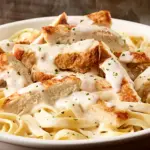Ingredients:
- For the Pasta:
- 1 pound elbow macaroni
- Salt for pasta water
For the Cheese Sauce:
- 4 tablespoons unsalted butter
- 4 tablespoons all-purpose flour
- 4 cups milk (whole milk preferred)
- 2 cups sharp cheddar cheese, shredded
- 1 cup Gruyère cheese, shredded
- 1/2 teaspoon Dijon mustard
- 1/4 teaspoon garlic powder (optional)
- Salt and pepper to taste
For the Topping (Optional):
- 1 cup breadcrumbs (preferably panko for extra crunch)
- 2 tablespoons melted butter
- 1/4 cup Parmesan cheese, grated
Instructions:
- Cook the Pasta:
- Bring a large pot of salted water to a boil. Add the elbow macaroni and cook according to package instructions until al dente. Drain and set aside.
- Make the Cheese Sauce:
- In a large saucepan, melt the butter over medium heat. Once melted, add the flour and whisk constantly for about 1-2 minutes to create a roux.
- Gradually add the milk to the roux, whisking continuously to avoid lumps. Continue to cook and stir until the mixture thickens, about 5-7 minutes.
- Once the sauce has thickened, reduce the heat to low and stir in the shredded cheddar and Gruyère cheese until fully melted and smooth.
- Stir in the Dijon mustard, garlic powder (if using), salt, and pepper to taste.
- Combine Pasta and Cheese Sauce:
- Add the drained pasta to the cheese sauce and stir until the pasta is evenly coated.
- Prepare the Topping (Optional):
- In a small bowl, combine the breadcrumbs, melted butter, and grated Parmesan cheese. Mix until the breadcrumbs are evenly coated.
- Bake (Optional):
- Preheat the oven to 350°F (175°C). Transfer the macaroni and cheese to a greased baking dish. Sprinkle the breadcrumb mixture evenly over the top.
- Bake in the preheated oven for 20-25 minutes or until the topping is golden brown and the sauce is bubbling.
- Serve:
- Serve hot and enjoy the creamy, cheesy goodness!
Origin Story of Macaroni and Cheese
Macaroni and cheese, a quintessential comfort food in many parts of the world, has a rich and varied history that traces back to the 14th century. The dish’s roots are believed to lie in Italy, where early recipes for “macaroni” (which referred to various pasta shapes, not just the elbow macaroni we know today) were combined with cheese.
One of the earliest recorded recipes for a dish resembling modern macaroni and cheese comes from the Italian cookbook Liber de Coquina (The Book of Cooking), written in the early 1300s. This recipe describes pasta sheets layered with cheese and butter, a precursor to what we now call lasagna.
Macaroni and cheese as we know it today became popular in England during the 18th century. The dish, known as “macaroni pudding,” was served as a sophisticated meal for the upper class. It was typically made with béchamel sauce (a white sauce made from roux and milk) and combined with Parmesan cheese.
The dish crossed the Atlantic to America with European immigrants, where it evolved into the beloved comfort food we know today. Thomas Jefferson, the third President of the United States, is often credited with introducing macaroni and cheese to America. After discovering the dish in France during his time as an ambassador, Jefferson imported a pasta-making machine to the U.S. and served the dish at a state dinner in 1802. However, it was not until the 20th century that the dish became widely popular, especially with the introduction of boxed macaroni and cheese by Kraft Foods in 1937, which made it an accessible and affordable meal during the Great Depression.
Today, macaroni and cheese is enjoyed in various forms worldwide, from simple stovetop versions to gourmet dishes with truffle oil and lobster. Despite its humble origins, macaroni and cheese has become a cultural icon, symbolizing warmth, nostalgia, and the simple pleasures of life.

